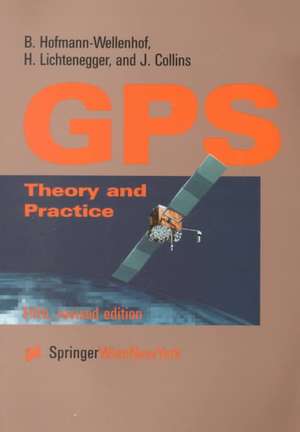Global Positioning System: Theory and Practice
Autor B. Hofmann-Wellenhof, H. Lichtenegger, J. Collinsen Limba Engleză Paperback – 10 ian 2001
Preț: 786.66 lei
Preț vechi: 959.34 lei
-18% Nou
Puncte Express: 1180
Preț estimativ în valută:
150.55€ • 156.59$ • 124.28£
150.55€ • 156.59$ • 124.28£
Carte tipărită la comandă
Livrare economică 14-28 aprilie
Preluare comenzi: 021 569.72.76
Specificații
ISBN-13: 9783211835340
ISBN-10: 3211835342
Pagini: 412
Ilustrații: XXIV, 382 p. 1 illus.
Dimensiuni: 170 x 244 x 21 mm
Greutate: 0.58 kg
Ediția:5th rev. ed. 2001
Editura: SPRINGER VIENNA
Colecția Springer
Locul publicării:Vienna, Austria
ISBN-10: 3211835342
Pagini: 412
Ilustrații: XXIV, 382 p. 1 illus.
Dimensiuni: 170 x 244 x 21 mm
Greutate: 0.58 kg
Ediția:5th rev. ed. 2001
Editura: SPRINGER VIENNA
Colecția Springer
Locul publicării:Vienna, Austria
Public țintă
Professional/practitionerCuprins
1 Introduction.- 1.1 The origins of surveying.- 1.2 Development of global surveying techniques.- 1.3 History of the Global Positioning System.- 2 Overview of GPS.- 2.1 Basic concept.- 2.2 Space segment.- 2.3 Control segment.- 2.4 User segment.- 3 Reference systems.- 3.1 Introduction.- 3.2 Coordinate systems.- 3.3 Time systems.- 4 Satellite orbits.- 4.1 Introduction.- 4.2 Orbit description.- 4.3 Orbit determination.- 4.4 Orbit dissemination.- 5 Satellite signal.- 5.1 Signal structure.- 5.2 Signal processing.- 6 Observables.- 6.1 Data acquisition.- 6.2 Data combinations.- 6.3 Atmospheric effects.- 6.4 Relativistic effects.- 6.5 Antenna phase center offset and variation.- 6.6 Multipath.- 7 Surveying with GPS.- 7.1 Introduction.- 7.2 Planning a GPS survey.- 7.3 Surveying procedure.- 7.4 In situ data processing.- 7.5 Survey report.- 8 Mathematical models for positioning.- 8.1 Point positioning.- 8.2 Differential positioning.- 8.3 Relative positioning.- 9 Data processing.- 9.1 Data preprocessing.- 9.2 Ambiguity resolution.- 9.3 Adjustment, filtering, and smoothing.- 9.4 Adjustment of mathematical GPS models.- 9.5 Network adjustment.- 9.6 Dilution of precision.- 9.7 Accuracy measures.- 10 Transformation of GPS results.- 10.1 Introduction.- 10.2 Coordinate transformations.- 10.3 Datum transformations.- 10.4 Combining GPS and terrestrial data.- 11 Software modules.- 11.1 Introduction.- 11.2 Planning.- 11.3 Data transfer.- 11.4 Data processing.- 11.5 Quality control.- 11.6 Network computations.- 11.7 Data base management.- 11.8 Utilities.- 11.9 Flexibility.- 12 Applications of GPS.- 12.1 General uses of GPS.- 12.2 Attitude determination.- 12.3 Airborne GPS for photo-control.- 12.4 Interoperability of GPS.- 12.5 Installation of control networks.- 13 Future of GPS.- 13.1 New application aspects.- 13.2 GPS modernization.- 13.3 GPS augmentation.- 13.4 GNSS.- 13.5 Hardware and software improvements.- 13.6 Conclusion.- References.
Recenzii
"... Although developed as a classroom text, the book is also useful as a reference source for professional surveyors and other GPS users. This because it covers both GPS fundamentals and leadingedge developments, thus giving it a wide appeal that will clearliy satisfy a broad range of GPS-philes ... The volume cogently presents the critical aspects and issues for users, along with the theory and details needed by students and developers alike. For those seriously entering the rapidly changing GPS field, this book is a good place to start.” GPS WORLD September"This is the fourth edition of the book, and the authors are to be congratulated on their efforts ... This book has now gained wide acceptance as a ‘serious’ book on GPS ... ”Navigation
Caracteristici
Revised edition of the classic reference book















